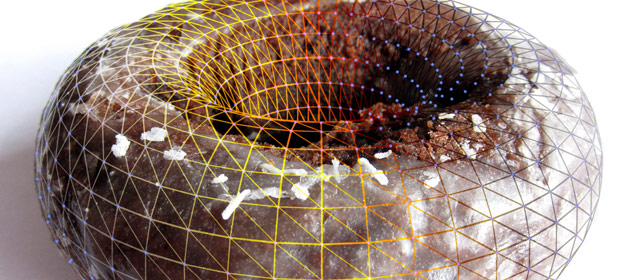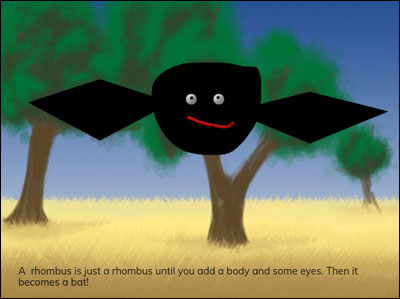
After reading The Shape of Things, students will compose images from shapes, write a sentence to describes their composition, and create their own version of the book.
Apps: Wixie

The world around you is made of amazing shapes. The clock in your classroom is probably round, but the one by your bed may be a square or rectangle. In this project, you will think of the shapes in objects around you, draw a picture and complete a shape sentence to make your own version of the book.
Ask students to find shapes around your classroom. While the clock is probably round and the whiteboard is probably a rectangle, see if students find shapes that are part of a group of shapes. For example, your pencil sharpener will have a hole where you insert the pencil, but the entire shape of the sharpener may be a rectangle or oval. As students call out shapes, highlight ones that are part of a group of shapes, and challenge them to find groups of shapes in your classroom.
Read the story the The Shape of Things by Dayle Ann Dodds and Julie Lacome. This rhythmic story showcases the basic shapes in common objects. As you read each page, have students look at the illustrations and name all of the shapes that they find.
After reading this story, tell the students that they will work in small groups to create their very own Shape of Things book.

Group students together to form small teams for each book. Assign each team member a basic shape like circle, square, triangle, rectangle, oval, and so on. Explain to students that each team member will create a page for the assign that includes an illustration made from a combination of shapes with their assigned shape as the base. Each student will then complete the following sentences:
A ________ (shape) is just a ________ (same shape) until you add ________. Then it becomes a ________!
For example: A circle is just a circle until you add a hole. Then it becomes a donut.
Use a digital publishing tool like Wixie to type the sentence and illustrate it.
Post the words for common shapes so that students can easily see how to spell them. Shape tools can be challenging to use for new computer users, so be sure to demonstrate how they work.
You may want to create a template that already includes the sentences and a basic shape, so that students simply have to illustrate and complete the sentences. If you are using Wixie, search “shape” to find templates you can use for rectangles, triangles, and circles.
You can let students draw whatever shape they want, but some may find it easier to see a picture in a shape that you have assigned. In any case, have students start by drawing the main, or largest shape first. Then add details to transform it into a special character, object, or location.

Be sure to have each student record their voice reading their sentences. Encourage them to practice before recording for the final time, or to preview the sound and try again. Have students save their files to a team folder. If one student finishes first, have them create the title page.
Combine individual student pages together using Wixie's Project Wizard feature. Then, print a copy of the book so that students can read and share with their families.
You may also want to export the book as a PDF or ePub file to share as an electronic book. These can include sound and are a prized keep sake for student families.
Share this version from your classroom web site or present it from a local computer.
Evaluation begins during your initial conversation about shapes in the classroom. Can students see and identify the shapes? How many different two-dimensional shapes can they identify and define? You can continue evaluating student learning as you read The Shape of Things to the class and have them find and identify shapes in the book.
As students work to write their initial sentence, work with individuals to help them visualize and describe. Encourage students to work together to think of details and descriptive words. You can evaluate their comprehension (and fine motor skills!) as you explore their illustration. Their recording, and practice before recording, will help build and assess reading fluency.
Dodds, Dayle Ann and Julie Lacome. The Shape of Things ISBN-10: 0613000560
Creativity, Curriculum, and Digital Age Learning - Connecting to Literature in Math
1.G.1. Distinguish between defining attributes (e.g., triangles are closed and three-sided) versus non-defining attributes (e.g., color, orientation, overall size) ; build and draw shapes to possess defining attributes.
1.G.2. Compose two-dimensional shapes (rectangles, squares, trapezoids, triangles, half-circles, and quarter-circles) or three-dimensional shapes (cubes, right rectangular prisms, right circular cones, and right circular cylinders) to create a composite shape, and compose new shapes from the composite shape.
Reading Standards
Key Ideas and Detail
1. Read closely to determine what the text says explicitly and to make logical inferences from it; cite specific text evidence when writing or speaking to support conclusions drawn from the text.
Speaking and Listening
Comprehension and Collaboration
2. Integrate and evaluate information presented in diverse media and formats, including visually, quantitatively and orally.
Speaking and Listening
Presentation of Knowledge and Ideas
6. Make strategic use of digital media and visual displays of data to express information and enhance understanding of presentations.
Writing Standards
Production and Distribution of Writing
4. Produce clear and coherent writing in which the development, organization, and style are appropriate
6. Creative Communicator
Students communicate clearly and express themselves creatively for a variety of purposes using the platforms, tools, styles, formats and digital media appropriate to their goals. Students:
a. choose the appropriate platforms and tools for meeting the desired objectives of their creation or communication.
b. create original works or responsibly repurpose or remix digital resources into new creations.
c. communicate complex ideas clearly and effectively by creating or using a variety of digital objects such as visualizations, models or simulations.
d. publish or present content that customizes the message and medium for their intended audiences.

Follow us on Instagram for daily inspiration

Create a thought web, cluster, flowchart, or other graphic organizer for a lesson
8 first projects to get students using technology
Creative, digital book reviews
Fun and powerful ideas with animated characters

Wixie
Share your ideas, imagination, and understanding through writing, art, voice, and video.

Rubric Maker
Create custom rubrics for your classroom.

Pics4Learning
A curated, copyright-friendly image library that is safe and free for education.

Wriddle
Write, record, and illustrate a sentence.

Get creative classroom ideas delivered straight to your inbox once a month.
Topics